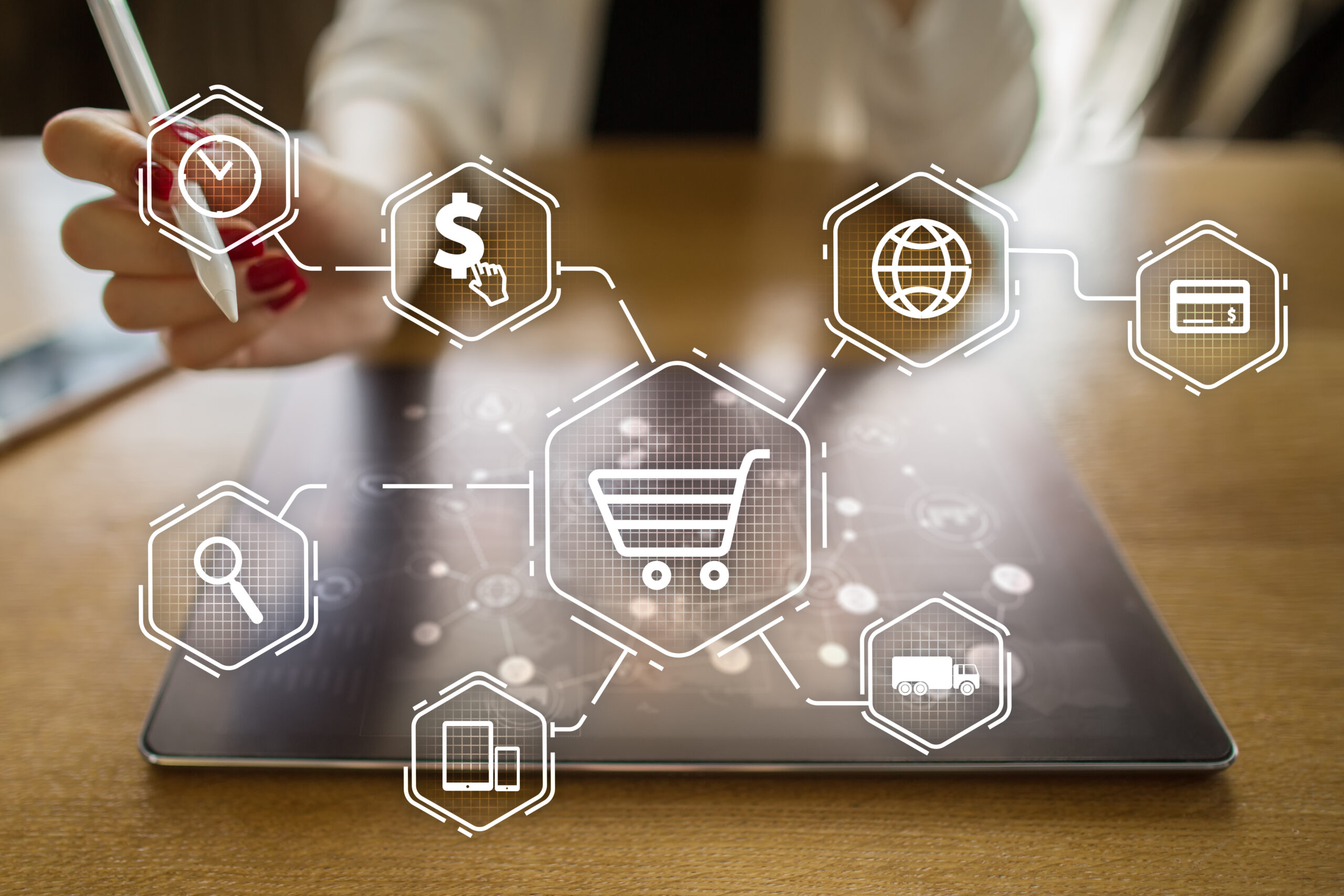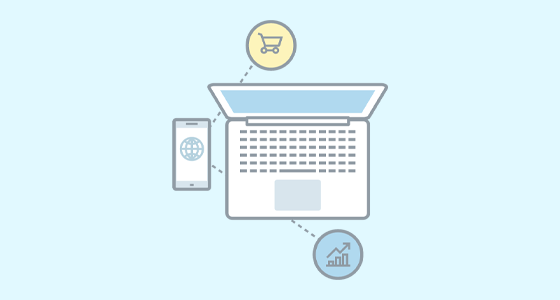
For today’s shopper, the best deals in town are often thousands of miles away in Shenzhen or Guangzhou. All they need to do to complete a purchase is make a few flicks of their thumb from a smartphone and wait for delivery direct to their door. In B2B commerce too, new digital channels and distribution models are allowing manufacturers and service providers to reach new markets.
So how do you position yourself as the Ecommerce business they choose to make that purchase? Most Ecommerce business models in use today allow you to reach your customers online without spending heavily upfront or even owning any inventory. Whether you’re starting an Ecommerce business entirely from scratch or adding an online store to your existing brick and mortar business, here’s how to set up quickly and easily.
How To Start an Ecommerce Business
There’s an enduring myth that Ecommerce is restricted to B2C sales, yet research by McKinsey shows that 65% of B2B companies now offer Ecommerce capabilities. The evidence is clear that online stores are the smart solution for B2B retailers too. The numbers don’t lie. The U.S. B2B Ecommerce market grew by 17.8% in 2021 and is expected to be worth $1.8 trillion by 2023. The beauty of Ecommerce is that it allows you to test a product or market without having to invest capital in a physical store, inventory or staff.
Most platforms are based on a monthly subscription plan, so costs are low, allowing you to scale affordably. That’s not to suggest that launching an Ecommerce store creates an ATM for your business. It’s a hyper-competitive landscape and you’ll need to spend a lot on sales and marketing just to get noticed. Average conversion rates hovered at 2.86% in 2020, so the ease of getting started doesn’t necessarily imply sales are easy to make.
Decide What You’re Going to Sell
If you’ve already got a great idea or unique product, Ecommerce allows you to bring it to a wider audience. Most sellers, however, begin with a revenue target before searching for the products that will help them fulfill it. The tools are readily available to find what’s hot. Google Trends or eComhunt, for example, will show you what’s trending at the moment. Your customers and competitors are also valuable sources of insight. Read the reviews and comments to see what your customers are really looking for, and check how your competitors are performing by looking at the response to their Facebook Ads or their SEMrush competitive analysis results.
It’s easy to be biased towards products that you and your team personally find interesting, but the key criteria your product search should meet are:
- Markup opportunity. Double-digit net profit margins are common in some sectors, although the average across all B2B industries hovers at just under 10%.
- Room for improvement. You’re probably going to have to evolve a product or service that your competitors already provide (or market it better). Unicorns are rare in Ecommerce too.
- Deliver the “Wow factor.” Your product has to improve your customer’s life. Purpose trumps novelty.
Source Your Product
It’s ridiculously easy to find products to sell online without ever even handling them yourself (although you should get samples). Dropshipping allows you to source products through Alibaba, Aliexpress, or Overstock, for example, and connect with a manufacturer or agent who takes care of the shipping. All you have to do is make the sale, and there is often no minimum sales volume required. As your business grows, you might want to engage with a wholesaler closer to home instead to unlock a more competitive deal on bulk orders. Ecommerce even allows you to launch a niche or artisanal product or service that you create. You’ll need to manage your demand forecasting and inventory management yourself, but it’s a direct-to-consumer strategy that can disrupt an existing market.
Create Your Platform
The online element of your Ecommerce business can be set up quite quickly if necessary, although there’s nothing to be gained by rushing the process. You’ll need:
Website
Buy a domain name, configure your store with the help of a Zoey onboarding expert, customize with our Visual Design Editor, add your third-party plugins for payment, fulfillment, analytics and so on and add your products. If you’re willing to keep things simple, you can quite easily build a workable storefront simply by following the prompts and selecting the options offered. You shouldn’t need any knowledge of coding or website design.
Email Marketing
Key to customer retention and bringing down the cost of conversions is your email marketing. Invite your site visitors to subscribe and send them automated campaigns and flows through platforms such as Klaviyo or Mailchimp that integrate seamlessly with your website.
Payment Providers
Mobile-friendly payment platforms such as PayPal and Stripe might keep B2C Ecommerce frictionless, but B2B customers will look to their bank’s robust security features and protection when it comes to placing large orders. B2B businesses should search for payment options that are better suited to big ticket purchases, automatic invoice resolution and cross-border currency transfers. Typically, that means being set up for Automated Clearing House payments, wire transfers and credit card payments.
Social Media
Unless you have a world-beating search engine optimization (SEO) strategy to generate organic traffic, you’ll need to drive customers to your store with social media. For B2B stores, it’s pertinent to be on LinkedIn to attract your demographic. However, other social media platforms like Facebook shouldn’t be overlooked.
Set Up Your Business
You’ll need a business entity to stay on the right side of the IRS and to steer clear of account blocks on Facebook or freezes on PayPal. Create a verified business identity with a registered address, Employer Identification Number (EIN) and business bank account, along with any local licenses or permits your state requires. This is also the moment to start building the brand behind your business. Create a logo, register any trademarks and establish any color palettes or fonts that will give your store a consistent look across all channels.
Build a Marketing Campaign
Expect to spend between 7% and 12% of revenue on sales and marketing, but for new companies, it can be as high as 20%. You’ll find an abundance of affordable tools to empower your sales teams, but even if you’re taking care of sales and marketing alone, you can typically manage your entire lead generation from a single dashboard. Try to include as many of the following as your budget permits:
- LinkedIn and Facebook ads: You can reach a sizable audience (1m+) by spending just $5 a day on each ad set. Ideally, you want to run multiple ad sets per campaign, each one targeting a unique audience. Make your budget go further by turning off those ad sets that deliver the lowest ROAS.
- Email marketing: Known to deliver an impressive return on investment (ROI), use your email channel to launch sales events, segment your customers into new, returning and VIPs and alert them to new products.
- Google PPC: These ads are not cheap and the marketplace is extremely competitive, but if you allocate budget to search ads, you’ll reach customers who show purchase intent.
- SEO optimization: Avoid using the standard product descriptions provided by your supplier and invest in a copywriter who can pick out the keywords to help your site rank better in organic search.
- Affiliate marketing: Essentially, you pay bloggers and reviewers a commission to link to your site through their platform. It’s particularly effective on YouTube and is often seen as more authentic and engaging by customers.
- Influencer outreach: Perhaps not a priority at launch, but influencers and journalists in your sector can be powerful advocates for your brand. Again, you pay a flat fee or commission structure for any sales they refer.
Growing Your Business
An Ecommerce store is not a “set and forget” project, even if many of the automated tools require minimum input. To grow revenue and focus on customer retention, have a strategy to take care of the following:
- A/B testing and optimization: Try different versions of emails, product shots, descriptions and offers, and pick the better performing campaigns.
- Customer loyalty programs: Take good care of your returning customers and reward them for their repeat business with discounts and sneak previews.
- Referrals: Make it easy for existing customers to refer friends and family (with rewards).
- Brand your products: Move as soon as possible from products shipped directly from the manufacturer to branded products that carry your logo and arrive with your own unboxing experience.
Watch out for These Key Challenges
A recurring theme by now is that the relative simplicity of Ecommerce can be deceptive. It’s easy to set up a store but hard to generate a consistent profit (particularly in year one). Here’s how to address the common obstacles any Ecommerce retailer will come up against:
Abandoned Carts
Beware that almost 70% of carts are abandoned in Ecommerce. That’s revenue left on the table, so fight back fast with an automated email flow, SMS or retargeting through social media to close the sale.
Customer Returns
In B2C Ecommerce, a staggering, 30% of items are returned on average and a refund has to be issued. But even in B2B Ecommerce, studies have shown that almost half of B2B buyers regularly experience online order errors with their suppliers. Returns represent a business cost, so make sure your product descriptions and images are accurate so that customers know what to expect, and respond fast to any delays in shipping — one of the most common reasons for customers to cancel an order.
Bad Reviews
You want to include trust badges and verified customer reviews on your site to build social proof, but you can’t avoid the occasional one-star rating. Where possible, respond promptly on the same thread so that other customers can see how quickly you resolve issues.
Customer Loyalty
It’s notoriously hard to nurture customer loyalty online, and just one bad experience can lose a customer forever. But 65% of your revenue will come from your existing customers, so turn shoppers into VIPs and shower them with loyalty rewards.
Restrictions and Regulations
Running social media advertising will be difficult for certain product categories (eg. CBD), and you must also stay on the right side of some pretty stringent marketing and data protection regulations, such as CAN-SPAM and GDPR or face heavy fines. Ensure that you obtain consent to contact your customers and that you take their data security seriously
How to Get Started with Zoey
Unleash the Zoey platform to tip the odds of Ecommerce success in your favor. It’s the secure, easy way to monitor your orders and inventory, allowing you to manage your orders and integrate third-party tools to stand out in the online marketplace. Our Customer Success Team is on hand every step of the way, guiding you through the process of setting up, personalizing and optimizing your store, growing your customer base and maximizing your sales. You can even manage a multi-store-like experience through a single Zoey account. It’s the quick, efficient and affordable to explore Ecommerce. Try a free demo today!
Nick Marshall is a freelance writer from the UK covering B2B marketing, emerging tech, payments and Ecommerce. He lives on a tiny island with slow internet in the French Caribbean, but was formerly an agency copywriter in the UK.





